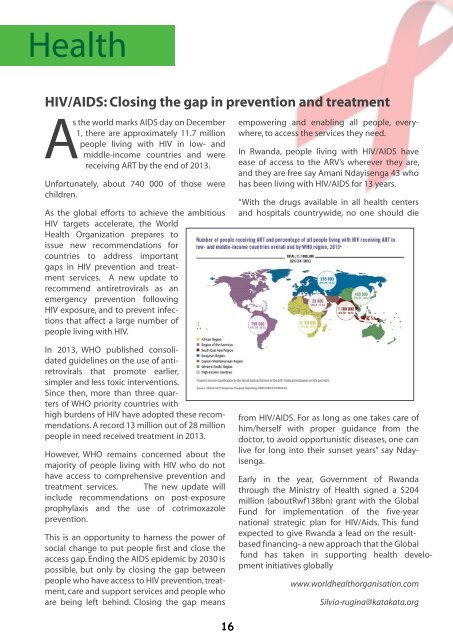2014 EDITION Vol.2 Issue 08 DIGITAL
Create successful ePaper yourself
Turn your PDF publications into a flip-book with our unique Google optimized e-Paper software.
Health<br />
HIV/AIDS: Closing the gap in prevention and treatment<br />
BY SILVIA RUGINA<br />
s the world marks AIDS day on December<br />
1, there are approximately 11.7 million<br />
people living with HIV in low- and<br />
middle-income countries and were<br />
receiving ART by the end of 2013.<br />
Unfortunately, about 740 000 of those were<br />
children.<br />
As the global efforts to achieve the ambitious<br />
HIV targets accelerate, the World<br />
Health Organization prepares to<br />
issue new recommendations for<br />
countries to address important<br />
gaps in HIV prevention and treatment<br />
services. A new update to<br />
recommend antiretrovirals as an<br />
emergency prevention following<br />
HIV exposure, and to prevent infections<br />
that affect a large number of<br />
people living with HIV.<br />
empowering and enabling all people, everywhere,<br />
to access the services they need.<br />
In Rwanda, people living with HIV/AIDS have<br />
ease of access to the ARV’s wherever they are,<br />
and they are free say Amani Ndayisenga 43 who<br />
has been living with HIV/AIDS for 13 years.<br />
“With the drugs available in all health centers<br />
and hospitals countrywide, no one should die<br />
In 2013, WHO published consolidated<br />
guidelines on the use of antiretrovirals<br />
that promote earlier,<br />
simpler and less toxic interventions.<br />
Since then, more than three quarters<br />
of WHO priority countries with<br />
high burdens of HIV have adopted these recommendations.<br />
A record 13 million out of 28 million<br />
people in need received treatment in 2013.<br />
However, WHO remains concerned about the<br />
majority of people living with HIV who do not<br />
have access to comprehensive prevention and<br />
treatment services. The new update will<br />
include recommendations on post-exposure<br />
prophylaxis and the use of cotrimoxazole<br />
prevention.<br />
This is an opportunity to harness the power of<br />
social change to put people first and close the<br />
access gap. Ending the AIDS epidemic by 2030 is<br />
possible, but only by closing the gap between<br />
people who have access to HIV prevention, treatment,<br />
care and support services and people who<br />
are being left behind. Closing the gap means<br />
from HIV/AIDS. For as long as one takes care of<br />
him/herself with proper guidance from the<br />
doctor, to avoid opportunistic diseases, one can<br />
live for long into their sunset years” say Ndayisenga.<br />
Early in the year, Government of Rwanda<br />
through the Ministry of Health signed a $204<br />
million (aboutRwf138bn) grant with the Global<br />
Fund for implementation of the five-year<br />
national strategic plan for HIV/Aids. This fund<br />
expected to give Rwanda a lead on the resultbased<br />
financing- a new approach that the Global<br />
fund has taken in supporting health development<br />
initiatives globally<br />
www.worldhealthorganisation.com<br />
Silvia-rugina@katakata.org<br />
16

















